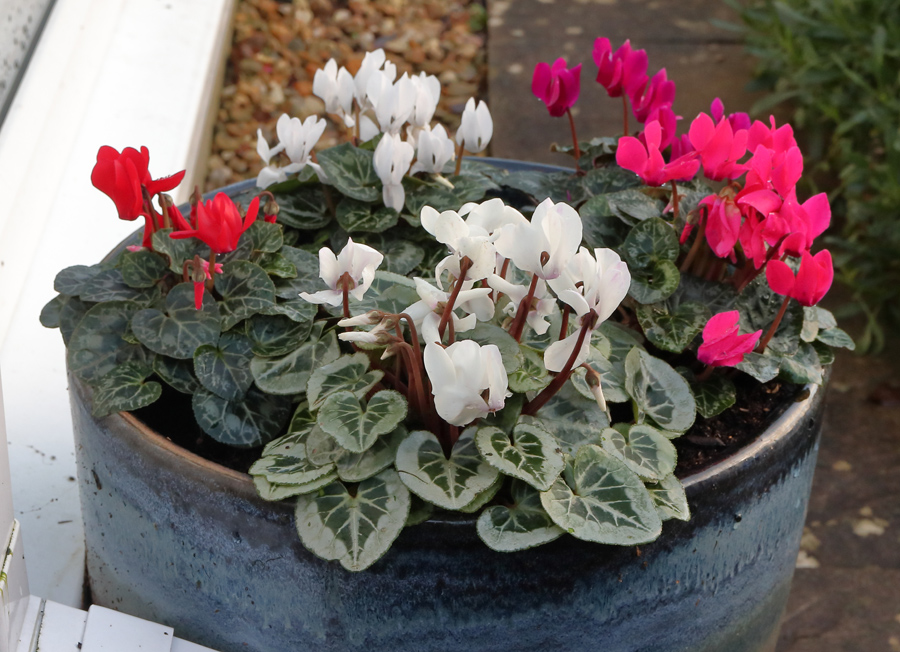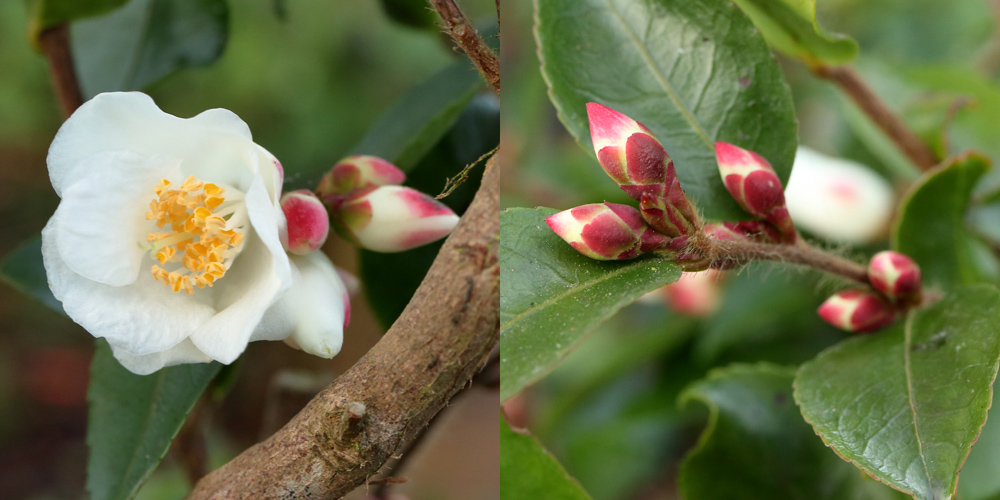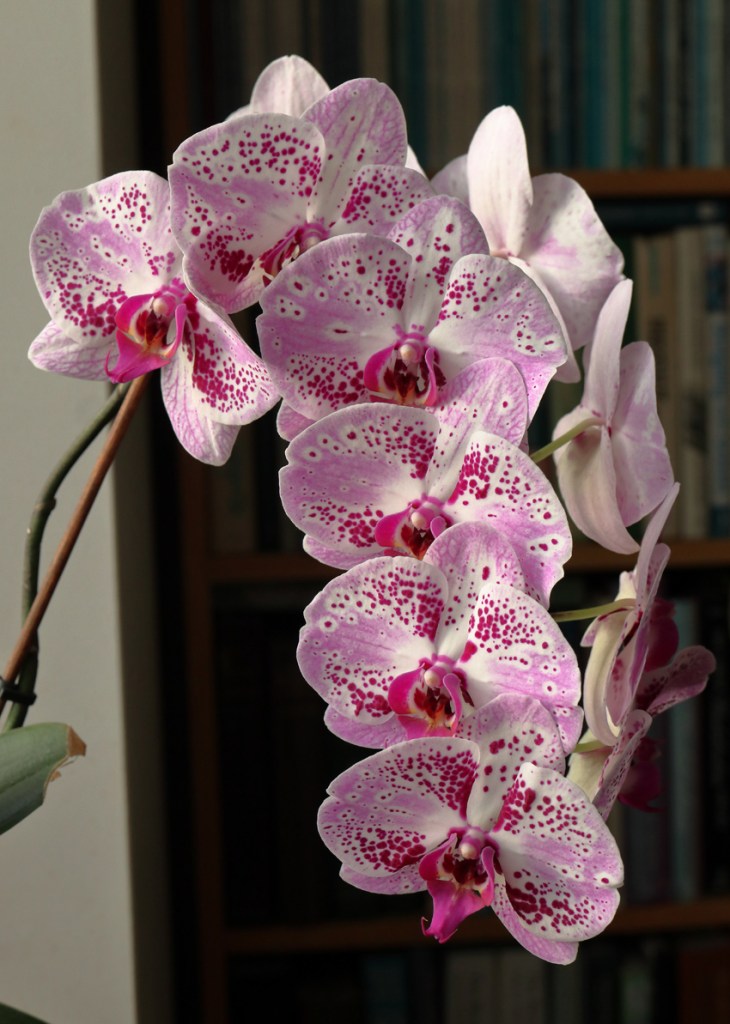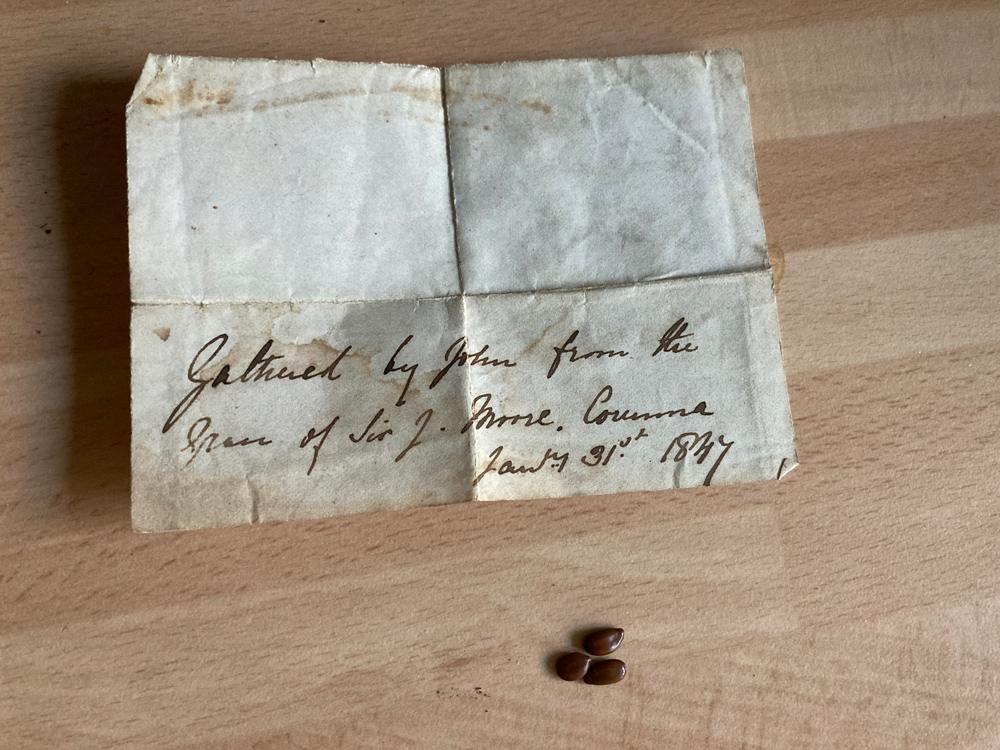Six things in the garden is it? You’re ‘avin’ a laugh guv. Rain, x 6. I usually take the pictures for my sixes on Friday, not a chance yesterday, solid rain from dawn ’til dusk, plus a few hours on either side. Today is very different, the sun is shining, the sky is blue. I ventured forth, camera in hand, looking for colours other than brown and green. Here’s what I found.
One.
Hydrangea serrata ‘Tiara’. I dug out and gave away my large bush of this about a year ago. It had really struggled through a couple of dry summers and obviously wanted more moisture or shade, which I couldn’t provide it with. I did take a few cuttings and now have three good little plants but still nowhere obvious to plant it. It’s just such a lovely variety I’m loathe to let it go. With a backdrop of collapsing Hedychium, it is the brightest bit of colour I could find.

Two.
We planted up a pot by the front door with violas a few weeks ago and pretty they looked for a short while, before succumbing to a rash of black spots and losing all their leaves and flowers. Sue picked up some cheap and cheerful cyclamen at the garden centre, hopefully they’ll fare better.

Three.
After that I had to look in the greenhouses for something happening. This time last year I had miniature daffs flowering but they’re only just breaking the surface this year. Because I want to grow loads of Camellias and don’t have room in the garden, several stay in pots, brought under cover during frost to protect the roots. C. transnokoensis is a very pretty thing, tiny leaves and flowers, very pretty buds. I took it outside to photograph and half the flowers promptly fell off. In the garden it will grow into an upright fine textured bush and get quite big.

Four.
Alstroemeria ‘Rock and Roll’ was never envisaged as an indoor plant, though I had considered keeping it in a pot. This being its first year I brought it into the glasshouse a couple of months back and it has just carried on throwing up new stems and flowering. I imagine ‘Indian Summer’ would do the same, but they’re all still outside. I imagine there are people on whom it’s subtle, understated charms would be lost but it takes all sorts.
Five.
Coming right into the house, our flowering houseplant of choice is Phalaenopsis in all its myriad forms. We’ve just about mastered the business of keeping them alive and in good nick so that they flower again. Sadly, that hard won knowledge is not always applied, providing an excuse to buy more.
Six.
I scurried out during the week to borrow a book from a gardening friend, an issue concerning Camellias as usual. She had found something about Camellias in another old gardening book that she had, but given that the book was from the 1880’s it was a bit out of date. Taped inside the cover of the book however, was a small brown envelope containing three seeds and a note. The seeds are nearly 174 years old. I have sown them. The chances of them growing must be almost zero but imagine if they did!
Not a drum was heard, not a funeral note,
As his corse to the rampart we hurried;
Not a soldier discharged his farewell shot
O’er the grave where our hero we buried
Charles Wolfe 1816
Sir John Moore died in the Battle of Corunna on 16th January 1809. Puts the current arguments over Europe in the shade. At least we’ve stopped knocking seven bells out of each other.
That was a struggle, getting six. By this time next week the days will be getting longer again, Christmas will be over and Covid will be all but over. Oops, alternative truth is creeping in. Check out everyone else’s sixes; the great thing about gardening is that in midwinter you can tell yourself it will get better without that feeling that you’re lying to yourself. Happy Christmas everyone.
(The featured image is Camellia sasanqua ‘Yume’)



I think it’s so exciting to have those ancient seeds and to plant them. How amazing it would be if they germinated. I shall await further news.
I posted an Alstroemeria this week too, as you know, and I’m thrilled with it. We have had quite a bit of rain since I planted it and the snails don’t seem to be interested in it (yet). I’m interested to see if the white part of the leaves develop more and become like those on your plant.
I see you mentioned in comments about the NZ Kauri museum. It’s a wonderful place to visit. Felled kauri is still found in swampy areas in NZ, and two saplings have been planted near a North Island town to remember my parents.
LikeLike
The New Zealand kauri is growing in a handful of gardens in the southwest corner of the UK but is very marginal. The Australian species won’t survive here. We visited the Waipoua Kauri Forest in torrential rain; such mixed emotions, great to see the big trees that remain, so sad to contemplate what has been destroyed. Even sadder that it still goes on in the Amazon, Tasmania, Malaysia, Russia and lots of other places.
LikeLike
Oh, how exciting. I do hope those seeds germinate. No need for special treatment. In my garden that is the usual way things die. Sow them and leave them to get on with it. I love the orchids – feed them all summer and they will flower for most of the winter. What is not to like? Merry Christmas.
LikeLike
I relented and brought the seeds in, to keep a close eye on them as much as anything. If I went out to the glasshouse and found one of the seeds had germinated but had then been eaten by slugs it would be too awful.
LikeLike
What a fabulous find, the note and seeds from so long ago. It will be absolutely wonderful if they did germinate! I like the Alstromeria ‘Rock and Roll’ especially its variegated foliage. Along with the flowers it is a double delight! The pot of Cycamen is looking lovely too. Wishing you a very Happy Christmas!
LikeLike
Alstroemeria ‘Rock and Roll’ is the perfect small garden plant, flowers for months and even when it’s not flowering it still looks good.
LikeLiked by 1 person
How exciting about the seeds Jim. I’m keeping everything crossed that they germinate. That would be so wonderful. Thanks for sharing all your wonderful plants over the year. I always enjoy dipping in and seeing what you’ve got going on there. Happy Christmas!
LikeLike
There’s been so much interest in the old seeds, I’m feeling the burden of expectation. Perhaps I should be treating them better, I just sowed them and put them in a cold greenhouse.
LikeLike
That would be rad to grow historic camellias from seed so old. I know it would have been nearly impossible for them to survive for so long, but heck, some seed can. I think that there would be a market for descendants of plants of historical significance. If I could, I would grow redwoods from suckers from the big Featherstone Tree in downtown Felton. I believe that tourists would like that, even though it is not a garden variety.
LikeLike
Well, there’s Isaac Newton’s apple tree, and that’s all I can think of. The advantage of suckers is they’d be physiologically juvenile, do even really old redwoods have them? Sequoia grows readily enough from cuttings, I’ve done many.
LikeLiked by 1 person
Cuttings from trees that were supposedly planted by Johnny Appleseed are also available, although supposedly not of good quality. (They are either understock or cider cultivars.)
Most of the massive (coastal) redwoods here grew from suckers from stumps of trees that were clear cut harvested more than a century ago. That is why they have multiple trunks, and why selective harvesting of the superfluous trunks would be beneficial to them. (They are getting too crowded as they mature.) The Featherstone Tree is an individual specimen that was never cut down, but has developed burls that will never stop suckering. I tried to remove the burls before, but it is nearly impossible to stop a tree from forming more burl once it starts, especially if well exposed. The juvenile phase of suckers is very brief. Weirdly, giant sequoias do not sucker, and simply die when cut down.
LikeLike
You would love the Kauri Museum in New Zealand, not far short of the history of a nation told through the story of one tree species. At least some of the buildings made from the wood are still standing, I don’t think Sequoia keeps nearly as well.
LikeLiked by 1 person
The two sequoias are very different from each other. (The giant redwood is now known as Sequoiadendron gigantea, rather than Sequoia gigantea.) The giant sequoia is the biggest tree in the World, and was historically cut down for bragging rights. Yes, capitalists at the time payed lumberjacks to cut them down so that they could get their pictures taken on the stumps. (They were they same sorts who shot buffalo from trains so that they could get pictures with a pile of carcasses.) The trees are so massive that they shattered when they fell. The wood was used primarily for grape stakes, stake fences and maybe shingles. So, the biggest trees in the World were used for trivial applications that other woods would have been adequate for. However, the coastal redwood, which is the tallest tree in the World is very useful. The wood is remarkably resistant to rot, which is why all the fences and decks here are made from it. A long time ago, before the lumber became as scarce as it is now, entire buildings were build from it. (Nowadays, only wood that is in contact with the foundations are redwood, while the rest of the buildings are Douglas fir.) The Winchester House in San Jose is made almost entirely from redwood, including some features that should have been made with hardwoods, such as flooring and trim. This region was harvested very extensively after the Great Earthquake and Fire, in order to rebuild San Francisco. Harvest continued as urban development accelerated in San Jose. That is why only a few virgin groves survive. The stumps of trees that were harvested a century ago are now a commodity. They are very popular for interior paneling in modern offices in Japan, and those who want it pay a lot of money for it. In my garden, one burned out hollow stump was made into a shower. Another was made into an outhouse. And, a third very large stump would have been built into a guest room if I had gotten around to it. The wood of the old growth trees is VERY resilient.
LikeLike
I hadn’t realised that Sequoia produced good and durable timber, though I did know that Sequoiadendron didn’t. Sequoia doesn’t grow terribly well here, though there are some good trees about. Sequoiadendron loves it here and there are big trees in every county. The tallest are 160 feet+, dating from 1853 onwards. There is an exquisite church in Cambridge, New Zealand, built entirely from kauri, it sounds like there are some equivalents in America. Felling old growth forest for timber breaks my heart in this day and age but much of it was done by emigrants from Britain where there has been none to fell for a couple of thousand years. We have remnants of ancient woodland here and there but if someone wants to build a road or railway the supposed protections that exist turn out to be toothless.
LikeLiked by 1 person
It is funny that giant sequoia does better there and elsewhere than it does here, seemingly closer to its natural habitat, and where the coastal redwood is native. It does not like mild climates, so actually prefers cooler winters. Forest Grove in Oregon is named for a grove of giant sequoias that were planted there at about the same time that they were planted in Europe. Many were planted all over at about that time, by prospectors returning home after the Gold Rush. A few were planted around the Santa Clara Valley by President Theodore Roosevelt (or, more accurately, by his staff, who then took photographs of him with a shovel.), while he was campaigning for the presidency, a few years prior to the Great Earthquake and Fire. I can remember the last few before they were cut down so that the roads could be widened. They were never happy here anyway, and were quite unsightly at the end.
All of our old buildings here (where I work), including the old chapel, are build with redwood, with some of the ponderosa pine. Wood from demolished buildings is recycled because it is ‘old growth’. It really is distinctive, although dark. To me, it is what old building such as these should be build from. It is part of our culture.
LikeLike
There’s a block of Sequoia in Rotorua, New Zealand, that they’ve kept in spite of having removed a lot of non native potentially invasive stuff, because it is so extraordinary. 200ft Sequoia with an understory of 50ft tree ferns. I need a pretext to put it in a six.
LikeLiked by 1 person
Those are some huge tree ferns! They get somewhat tall in Southern California, but look tattered once they grow higher than what had sheltered them from the wind.
LikeLiked by 1 person
We can always rely on you for a fabulous camellia. Are the seeds camellia seeds? How exciting it would be if they germinated!
LikeLike
No, not Camellia seeds, most likely broom. It would be exiting if Camellia seeds germinated after one year, never mind 174, they don’t keep well.
LikeLiked by 1 person
” I imagine there are people on whom it’s subtle, understated charms would be lost but it takes all sorts” Were you being ironic? Now if you were alluding to the subtle Camelia, that could be so, which I think is charming. I’ve been to that grave in La Corruna but sadly have no recollection of what was growing there. Lovely place and well worth visiting at the very north west tip of Spain. Happy Christmas.
LikeLike
I was definitely being ironic, it’s the brashest plant I have and I love it. I just found a picture of Moore’s grave, it looks too well tended for seeds of anything to be gleaned. It was probably different 174 years ago. https://www.tracesofwar.com/sights/103146/Grave-of-Sir-John-Moore.htm
LikeLike
Can’t wait to see if the seeds do germinate, however small the chances. The leaves of Alstroemeria ‘Rock and Roll’ are just as lovely as the flowers.
LikeLike
I came across one reference to 1% broom seeds surviving 81 years, so it’s not impossible.
LikeLiked by 1 person
People had such beautiful handwriting 174 years ago! Would be wonderful if they germinate, even if they’re broom.
LikeLike
Perhaps we should all tape a few seeds inside a book, for future generations. I wonder why they kept them rather than sowing them at the time. Just a memento removed without doing any damage perhaps.
LikeLiked by 1 person
I like that idea, a kind of literary seed-bank.
LikeLiked by 1 person
Such a lovely post considering there isn’t much to talk about at the moment. Your Hydrangea is lovely as is the variegated alstroemeria and I always like to see your camellias. The note and the seeds are a wonderful find. Good luck with the sowing.
LikeLike
Thank you. By the end of friday I had one item for the six and no pictures, there always seems to be something when I look hard enough.
LikeLike
Whatever the seeds, it will be interesting to see if they germinate – and the note itself is a little treasure.
LikeLike
The note should go back in the book with another note telling when the seeds were sown and whether they grew. Then in 2194 someone else can have a little dose of wonder. I’m assuming rather a lot here.
LikeLiked by 1 person
But it is worth doing it nonetheless.
LikeLiked by 1 person
When yours grow and set seed, you can put some back into the book! Reminds me of the 2000 year old Magnolia that germinated and Sir David Attenborough talked about. I do wonder if really was 2000 though. https://www.youtube.com/watch?v=RNMD9siznOo&fbclid=IwAR3SXMUfRO_hjuElINAvpuLtt4ivmwpEITW8h4kiXXlekZq6H7oVAxvSNts
LikeLike
Yes, it’s a great story but begs as many questions as it answers.
LikeLike
Your final picture gave me tingles, I love that kind of thing. Fingers crossed you get germination, they look very healthy to me. I wonder, who, why and what?! Lovely camellias of course. Have a wonderful Christmas. 🙂
LikeLike
I suspect they’re broom seeds and if they do germinate they will be going back to the lady who gave me the seeds. I’ll keep the photos as a memento. Happy Christmas to you too.
LikeLiked by 1 person
And share any updates with us I hope!
LikeLike
For sure!
LikeLike
I’m sure you will keep us posted as to how those seeds fare, good luck with that! You may have seen that I have planted some cyclamen this week as well. They are such cheerful colours at this time of year. Have a good Christmas and maybe on one of our trips to St Austell – if they go ahead – we will come to see your Open Garden, if that goes ahead, I do hope so.
LikeLike
It’d be great if you did make it down when we have the garden open. I just looked at your six, will comment in your comments rather than mine.
LikeLike
Fantastic these 174-yo seeds! We don’t know if they will germinate, but just to find an envelope with writing from that time must be very touching. The alstroemerias that you presented to us are very pretty , first by the dark red colour of the flowers but also by the variegated leaves. Have a merry Christmas Jim
LikeLike
If, as I suspect, they are common broom, cytisus scoparius, and they do germinate, what on earth do I do with them. It’s one of the most widespread weeds in the world.
LikeLiked by 1 person
Just for fun… 😂
LikeLiked by 1 person
There is another version of that poem with the slightly modified line:-
“As his horse on the ramparts we curried”……
Sorry about that!
Good luck with the seeds. You never know. What do you think they are of?
LikeLike
I think the seeds are broom, which makes me think it is just possible they may be viable.
LikeLike